Crab
![]()
Krabbe is a redirect to this article. For other meanings, see Crab (disambiguation).
The crabs (Brachyura) - also true crabs or short-tailed crabs - are the largest infraorder of the order Decapoda, with about 6,800 species. Most crab species live in the sea, but some live in freshwater (see freshwater crab) or on land. Crabs have an abdomen (pleon) that has been transformed into a short caudal plate, which lies folded over under the cephalothorax - the space in between serves as a brood chamber in females.
The male mating organs (gonopods) of the crabs are derived from double-branched split feet, whereby the latter are still found as pleopods in females (these are used in brood care and can carry hundreds of thousands of eggs). In males, pleopods have regressed or disappeared altogether. Only the first two pairs of pleopods are regularly preserved as gonopods: The first pair is tubular, the second mostly filiform and situated within the tube of the first, probably following a piston-pump principle. The first pair of legs of the trunk is remodeled into large scissors, and the eyes are on stalks. Crabs can walk remarkably fast sideways ("crab walk").
Some crab species are considered delicacies, especially edible crabs, deep-sea crabs and Japanese giant crabs.
Also various other crab species have a crab-like physique and are accordingly called so, especially the family of stone and king crabs. Thus, in northern Germany, contrary to zoological custom, shrimp are also called "crabs" (see crab fishing). In kitchen language, crab usually means shrimp - especially North Sea shrimp (see North Sea crab).
Systematics
The families of crabs:
- Podotremata (de Haan, 1833)
- Superfamily Cyclodorippoidea (Ortmann, 1892)
- Cyclodorippidae (Ortmann, 1892)
- Cymonomidae (Bouvier, 1897)
- Phyllotymolinidae (Tavares, 1998)
- Superfamily Homolodromioidea (Alcock, 1900)
- Homolodromiidae (Alcock, 1900)
- Superfamily Dromioidea (de Haan, 1833)
- Sponge crabs (Dromiidae) (de Haan, 1833)
- Dynomenidae (Ortmann, 1892)
- Superfamily Homoloidea (de Haan, 1839)
- Homolidae (de Haan, 1839)
- Long-legged crabs (Latreilliidae) (Stimpson, 1858)
- Poupiniidae (Guinot, 1991)
- Superfamily Raninoidea (de Haan, 1839)
- Raninidae (de Haan, 1839)
- Symethidae (Goeke, 1981)
- Eubrachyura (de Saint Laurent, 1980)
- Heterotremata (Guinot, 1977)
- Superfamily Dorippoidea (MacLeay, 1838)
- Dorippidae (MacLeay, 1838)
- Orithyiidae (Dana, 1853)
- Superfamily Calappoidea (Milne Edwards, 1837)
- Boxer crabs (Calappidae) (Milne Edwards, 1837)
- Hepatidae (Stimpson, 1871)
- Superfamily Leucosioidea (Samouelle, 1819)
- Spherical crabs (Leucosiidae) (Samouelle, 1819)
- Matutidae (de Haan, 1841)
- Superfamily Majoidea (Samouelle, 1819)
- Epialtidae (MacLeay, 1838)
- Inachidae (MacLeay, 1838)
- Inachoididae (Dana, 1851)
- Triangular crabs, spider crabs, spider crabs, decorator crabs (Majidae) (Samouelle, 1819)
- Mithracidae (Balss, 1929)
- Pisidae (Dana, 1851)
- Tychidae (Dana, 1851)
- Superfamily Hymenosomatoidea (MacLeay, 1838)
- False spider crabs (Hymenosomatidae) (MacLeay, 1838)
- Superfamily Parthenopoidea (MacLeay, 1838)
- Aethridae (Dana, 1851)
- Dairidae (Ng & Rodriguez, 1986)
- Daldorfiidae (Ng & Rodriguez, 1986)
- Parthenopidae (MacLeay, 1838)
- Superfamily Retroplumoidea (Gill, 1894)
- Retroplumidae (Gill, 1894)
- Superfamily Cancroidea (Latreille, 1802)
- Atelecyclidae (Ortmann, 1893)
- Edible crabs, rock crabs (Cancridae) (Latreille, 1802)
- Cheiragonidae (Ortmann, 1893)
- Corystidae (Samouelle, 1819)
- Pirimelidae (Alcock, 1899)
- Thiidae (Dana, 1852)
- Superfamily Portunoidea (Rafinesque, 1815)
- Carcinidae (MacLeay, 1838)
- Catopidae (Borradaile, 1902)
- Deep-sea crabs (Geryonidae) (Colosi, 1923)
- Macropipidae (Stephenson & Campbell, 1960)
- Primelidae (Alcock, 1899)
- Swimming crabs (Portunidae) (Rafinesque, 1815)
- Thiidae (Dana, 1852)
- Superfamily Bythograeoidea (Williams, 1980)
- Bythograeidae (Williams, 1980)
- Superfamily Xanthoidea (MacLeay, 1838)
- Carpiliidae (Ortmann, 1893)
- Eumedonidae (Dana, 1853)
- Goneplacidae (MacLeay, 1838)
- Hexapodidae (Miers, 1886)
- Menippidae (Ortmann, 1893)
- Panopeidae (Ortmann, 1893)
- Woolly crabs (Pilumnidae) (Samouelle, 1819)
- Platyxanthidae (Guinot, 1977)
- Pseudorhombilidae (Alcock, 1900)
- Coral crabs (Trapeziidae) (Miers, 1886)
- Round crabs (Xanthidae) (MacLeay, 1838)
- Superfamily Bellioidea (Dana, 1852)
- Belliidae (Dana, 1852)
- Superfamily Potamoidea (Ortmann, 1896)
- Deckeniidae (Ortmann, 1897)
- Platythelphusidae (Colosi, 1920)
- Potamidae (Ortmann, 1896)
- Potamonautidae (Bott, 1970)
- Sudanonautes (Bott, 1955).
- Superfamily Pseudothelphusoidea (Ortmann, 1893)
- Pseudothelphusidae (Ortmann, 1893)
- Superfamily Gecarcinucoidea (Rathbun, 1904)
- Gecarcinucidae (Rathbun, 1904)
- Parathelphusidae (Alcock, 1910)
- Superfamily Cryptochiroidea (Paulson, 1875)
- Gall crabs (Cryptochiridae) (Paulson, 1875)
- Thoracotremata (Guinot, 1875)
- Superfamily Pinnotheroidea (de Haan, 1833)
- Pinnotheridae (de Haan, 1833)
- Superfamily Ocypodoidea (Rafinesque, 1815)
- Camptandriidae (Stimpson, 1858)
- Dotillidae (Stimpson, 1858)
- Heloeciidae (H. Milne-Edwards, 1852)
- Macrophthalmidae (Dana, 1851)
- Soldier crabs (Mictyridae) (Dana, 1851)
- Ocypodidae (Rafinesque, 1815)
- Palicidae (Bouvier, 1898)
- Ucididae (Števčić, 2005)
- Xenophthalmidae (Stimpson, 1858)
- Superfamily Grapsoidea (MacLeay, 1838)
- Land crabs (Gecarcinidae) (MacLeay, 1838)
- Glyptograpsidae (Schubart, Cuesta & Felder, 2002)
- Square crabs (Grapsidae) (MacLeay, 1838)
- Plagusiidae (Dana, 1851)
- Sesarmidae (Dana, 1851)
- Varunidae (Milne Edwards, 1853)

Blue soldier crabs (Mictyris longicarpus)

Chinese mitten crab (Eriocheir sinensis)
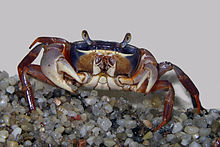
Harlequin crab (Cardisoma armatum)
.jpg)
West Atlantic horseshoe crab (Ocypode quadrata)
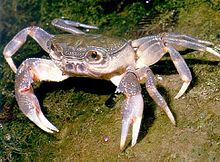
Potamon fluviatile
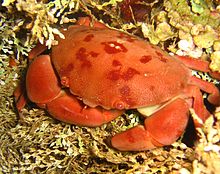
Atergatis subdentatus

Atelecyclus rotundatus
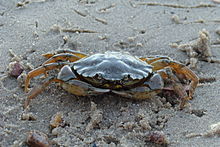
Common shore crab (Carcinus maenas)

Japanese giant crab (Macrocheira kaempferi)
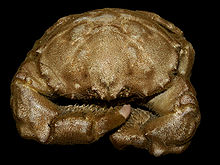
Dromia personata
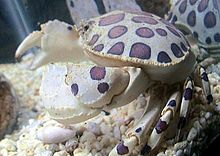
epithelial hepatitis
Questions and Answers
Q: What are crabs?
A: Crabs are a type of decapods that have eight walking legs and two grasping claws.
Q: What is their order within the decapods called?
A: Their order within the decapods is called Brachyura.
Q: Are crabs successful?
A: Yes, crabs are an extremely successful group found all over the world.
Q: What is the size of the smallest crab?
A: The smallest crabs are the size of a pea.
Q: Do all crabs live in sea-water?
A: No, there are some crabs that live in fresh water and some that live on land.
Q: What is the size of the largest crab?
A: The largest crab, the Japanese spider crab, grows to a leg span of 4 meters.
Q: How many species of crabs are known?
A: About 7,000 species of crabs are known.
Search within the encyclopedia